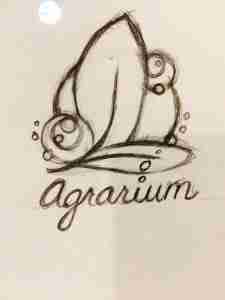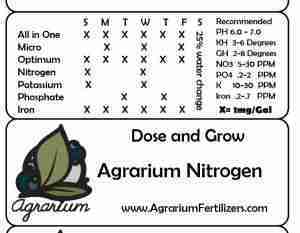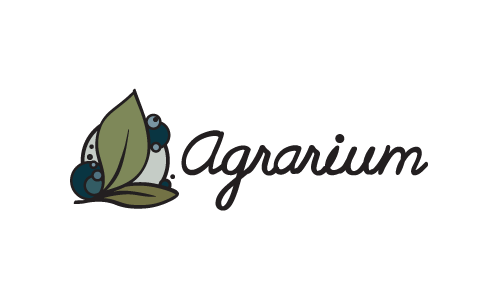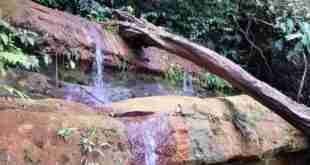 Growing aquatic plants in your aquarium doesn’t have to be extremely difficult or require expensive tools. Of course they will help and as you become more experienced you may begin to utilize them to your advantage. For the average beginner this can be overwhelming and expensive. There are a multitude of do it yourself fertilizing regiments that you can use as well as multiple brands of commercially available mixes for the hobbyist. We mix Agrarium which is our own fertilizer for a wide range of applications, it works well and it is easy to measure and dose.
Growing aquatic plants in your aquarium doesn’t have to be extremely difficult or require expensive tools. Of course they will help and as you become more experienced you may begin to utilize them to your advantage. For the average beginner this can be overwhelming and expensive. There are a multitude of do it yourself fertilizing regiments that you can use as well as multiple brands of commercially available mixes for the hobbyist. We mix Agrarium which is our own fertilizer for a wide range of applications, it works well and it is easy to measure and dose.
We have been using home brew fertilizers (soils and substrates too) in our planted tanks, terrariums, emersed plants, wabi kusa, and terrestrial plants instead of buying premixed fertilizer or using separate dry fertilizers. Initially it was done to save space and money as multiple boxes of other fertilizers took up a lot of room and the cost to keep a supply of specialty fertilizers ate into the plant and fish buying budget. Mixing our own for particular applications made the most sense for the wide range of plants and uses that we have.
It isn’t anything fancy or top secret that we use. Its a blend of fertilizer that we started modifying to better suit our needs and budget. There’s no underground bunker where scientific experiments were carried out using overly advanced equipment or techniques. Its just a blend of fertilizers, vitamins, and minerals that work for us and most everyone else that’s tried them.
There’s a lot going on around here and time is of the essence so something simple to use was needed over the constant water parameters testing some methods of planted tank fertilizer practices use. We use the liquid fertilizer and use the Dose and Grow Chart depending on the tanks needs. It’s not rocket science to mix up a suitable fertilizer, it just takes time and experience.
In fact, there’s a ton of information about how to mix your own from dry ingredients that are posted online. This is pretty much the beginning of the journey we started on years ago. The information largely available is pretty accurate and detailed enough that you can buy your own and mix them up. After deciding which kind of methods you want to use to run your tank you can get busy getting your fertilizers mixed and dosing.
If you don’t want to mix the basics available then you can try Agrarium. It is easy to dose with 1ml per gallon and an easy Dose and Grow Chart to help you know when to dose. If you have a 7 gallon aquarium, then you would use 7ml. If you have a 30 gallon planted aquarium then 30ml would be your dose for a standard growth planted tank. For heavily planted tanks and high light plants you can add half again the dose, or 1.5mg per gallon. Simple to measure and simple to use.
 We were using a method that tests water parameters for things like iron, nitrogen, and similar nutrients and make small adjustments with dry powdered nutrients. That took a lot of time that could be used elsewhere like propagating plants or building wabi sabi We simply cut out much if not all the water parameter testing in most tanks and dose depending on a few factors like plant load and lighting. We also practice regular water changes in the tanks, tubs, bins, and buckets.
We were using a method that tests water parameters for things like iron, nitrogen, and similar nutrients and make small adjustments with dry powdered nutrients. That took a lot of time that could be used elsewhere like propagating plants or building wabi sabi We simply cut out much if not all the water parameter testing in most tanks and dose depending on a few factors like plant load and lighting. We also practice regular water changes in the tanks, tubs, bins, and buckets.
Agrarium is more than just the basic mixtures we found on the internet years ago. Experience with planted tanks, forced CO2, and other plant projects led to using other nutrients, vitamins, and minerals. They could do without them as is proof of the DIY fertilizer methods we started with however the additional offerings added help plant growth.
To begin with we were using N, P, and K separately and measuring what nutrients were lacking and adjusting with that. That took time so the NPK was combined together and the micro nutrients and iron were added separately. After running across how to mix all three together and avoid precipitation we started doing that. Later on more and more nutrients we added in the micronutrient are to help with plant growth and health.
In the end we were mixing a nitrogen, potassium, phosphate, micro, iron, and CO2 supplements as well as the All in One. In the tanks that we measure all the nutrients we use the N or the micro or whatever is lacking after testing the water parameters. In the general tank the All in One is put in through a weekly regimen of dosing and water changes. The foliar spray is something that we had been doing all along but decided to add it in for our emersed plants and wabi kusa after taking notes on how we had been mixing it.
This isn’t a reinvention of the wheel but a simplification of fertilizers with some extras thrown in through our experience in keeping plants both emsersed, terrestrial, and aquatic. It allows you to easily get into planted tanks, keeping emersed grown plants, wabi kusa, and terrestrial plants. Everything is premixed and ready to use without breaking the bank like some of the commercially available mixes are. It saves time and the hassle of measuring small amounts of dry fertilizers which tend to vary in weight every time you scoop them, even with the same scoop.

Agrarium and Dose and Grow copyright 2014 property of Biotope One Patent Applied For
 Biotope One A Study of Flora and Fauna
Biotope One A Study of Flora and Fauna 


